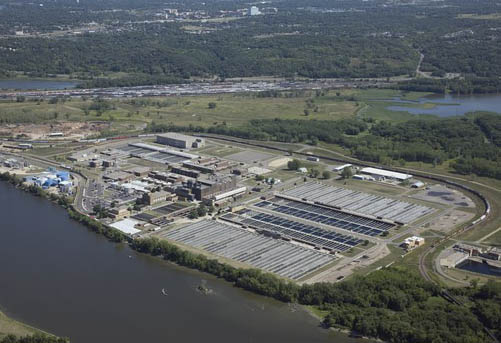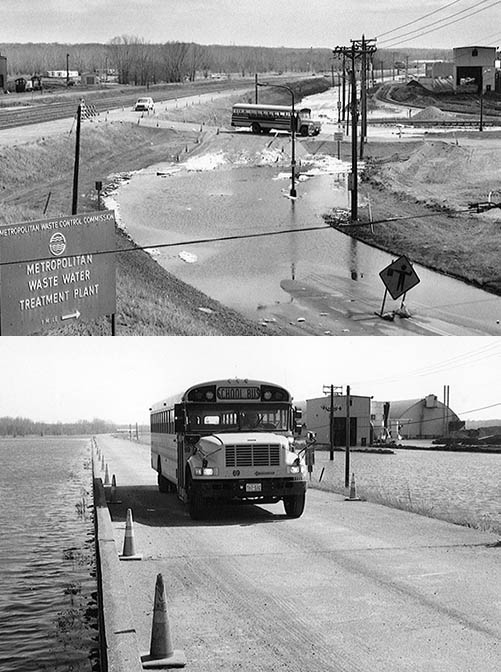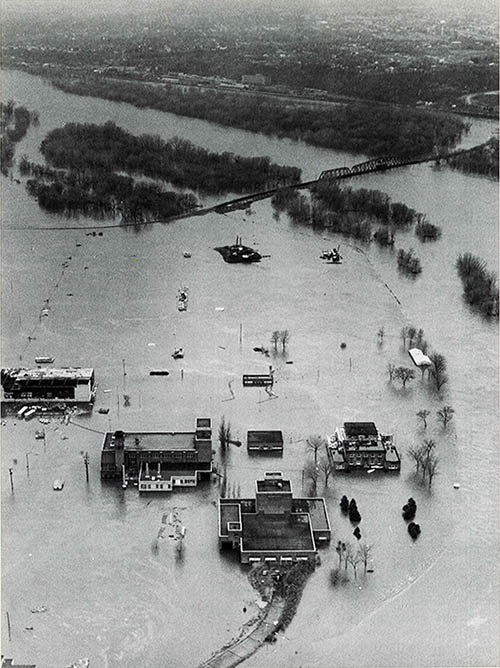The clock has started ticking on flood preparations at the massive Metropolitan Wastewater Treatment Plant on the Mississippi River in Saint Paul.
 On March 12, the river level at the plant was just below its normal average, which is 687.2 feet above sea level. After a week of daytime temperatures in the 30s and low 40s — but nighttime temperatures below freezing — the river was slowly rising and closing in on 690.
On March 12, the river level at the plant was just below its normal average, which is 687.2 feet above sea level. After a week of daytime temperatures in the 30s and low 40s — but nighttime temperatures below freezing — the river was slowly rising and closing in on 690.
As of March 25, the National Oceanic and Atmospheric Administration (NOAA) was predicting that the Mississippi will rise to about 704 feet above sea level in downtown Saint Paul by March 29, which is considered major flood level.
But well before the river started to rise, the Flood Team at the Metro Plant had reviewed and updated flood response plans.
“We stage our response according to how high the river is,” explained Mike Mereness, who manages wastewater collection and treatment at the Metropolitan Council. “Each benchmark initiates the next phase of activities, all geared toward keeping the plant in full operation during the flood and continuing to meet our clean water discharge permit requirements.”
Slow rise of the river provides an advantage
When it comes to spring flooding, the Metro Plant and its staff have several big advantages — time, experience, and infrastructure that provides access to and protects the plant.
“It’s not like a tornado or a flash flood,” Mereness said. “The mighty Mississippi gives us enough time to get ready.”
A gauge on the river in downtown Saint Paul measures the elevation every 15 minutes. The Flood Team also has access to automated readings from a station near the end of the channel where cleaned wastewater — called effluent — enters the Mississippi from the plant.
Put together with weather forecasts and river level predictions based on sophisticated computer modeling from NOAA, the team is armed with sufficient data to carry out its work.
From buying supplies to building a temporary road
 Before the river starts rising, plant staff order supplies they will need to last through a potential flood (for example, chemicals used in the treatment process). That’s because once Childs Road — the primary access to the plant — floods (at about 700 feet), big supply trucks can’t get to the plant.
Before the river starts rising, plant staff order supplies they will need to last through a potential flood (for example, chemicals used in the treatment process). That’s because once Childs Road — the primary access to the plant — floods (at about 700 feet), big supply trucks can’t get to the plant.
But small trucks and cars can. The massive regional sanitary sewers that carry wastewater into the plant (nicknamed The Barrel) are topped with a thick, flat and wide concrete surface that can safely support lighter vehicles. To provide access to the top of The Barrel, the Council calls in an emergency contractor to construct a temporary road across the soon-to-be-flooded Childs Road for the duration of flooding. The road, made from reused gravel stored from previous floods on adjacent city land, can be built in about 12 hours and is about 11.5 feet high.
If Childs Road is predicted to flood, the Saint Paul Fire Department brings a firetruck into the plant ahead of time in case it’s needed.
Plant staff provide river level information to industrial facilities between Childs Road and the river, and coordinate with the BNSF railroad, which has tracks going through the plant property.
Pumps keep effluent flowing out of the plant
During most of the year, treated wastewater flows by gravity out of the plant, down the channel and into the river. But when the river floods, the effluent backs up in the channel.
“We put massive pumps into service to raise the effluent to the higher river level,” Mereness said. “We need electricians on site 24/7 to make sure the pumps keep running.”
Another part of the treatment process that’s affected by flooding is chlorination and dechlorination, the last stages of treatment.
The treatment process at the plant is largely either mechanical (screening out bigger objects as the wastewater comes into the plant, for example, or scraping off the muck that ends up at the bottom of settling tanks), or biological — helpful bacteria eat the pollutants in the wastewater. Most of the bacteria die in the process and are part of the solids that get incinerated at the plant. Some bacteria survive and are cycled back into the treatment process. And some survive in the water headed for the effluent channel.
Those bacteria are eliminated with chlorine, but then the residual chlorine must be removed in the effluent channel. When the channel reaches a certain stage of flooding, the chlorination/dechlorination process must be suspended. Despite that, the plant has met treatment standards during the flood season for the last 25 years.
More river flooding has occurred in recent years
 The river has reached major flood stage in four years since 1993, the worst in 2001, when it reached 705 feet. That’s about two feet short of the modern record of 706.9 in 1965 — about 20 feet above normal. That year the Metro Plant was inundated, though 41 workers who were stranded at the plant for 12 days prevented the worst damage to plant equipment. The plant was shut down for three weeks after the river crested to clean up the mess left by the flood.
The river has reached major flood stage in four years since 1993, the worst in 2001, when it reached 705 feet. That’s about two feet short of the modern record of 706.9 in 1965 — about 20 feet above normal. That year the Metro Plant was inundated, though 41 workers who were stranded at the plant for 12 days prevented the worst damage to plant equipment. The plant was shut down for three weeks after the river crested to clean up the mess left by the flood.
Read an account of the 1965 flood at the Metro Plant.
That disaster created the impetus for construction of a mile-long concrete floodwall, completed in 1975, to protect the plant. It tops off at 716 feet above sea level. Flood water must reach 708.7 feet before it covers The Barrel, though wave action can create havoc at slightly lower levels.
Heavy rains can change the equation
In addition to the amount of snow on the ground, rainfall can greatly impact both the level of flooding and the speed at which the river rises. In some recent years, flooding has occurred well after all the snow is gone due to torrential rainfalls in May and June.
“We’ve had a lot of experience with flood preparation at the plant in recent years,” Mereness said. “We’ll be ready for the flood that’s predicted this year.”